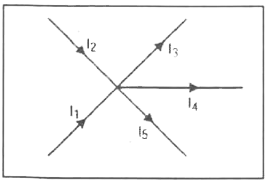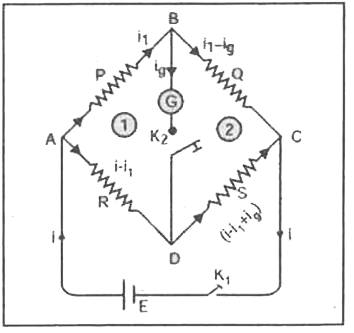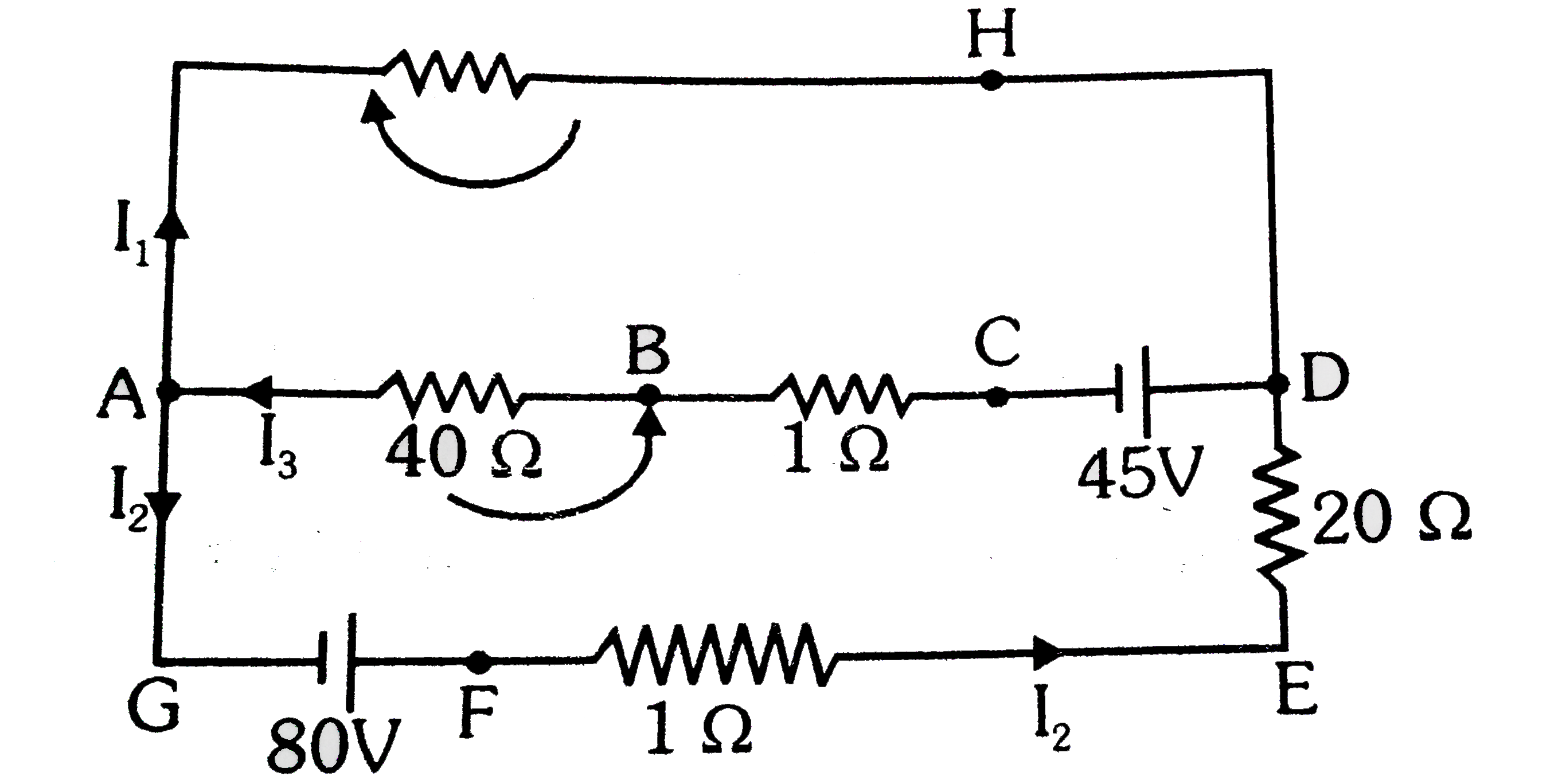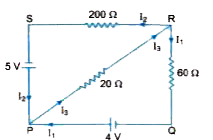What is Kirchhoff's loop rule.
Video Solution
Text Solution
Junction. It is apont where two or more conductors are connected to source and current gets distributed at the point.
Loop. Loop is a closed path of an electric circuit.

Kirchhoff.s First Law of Junction Rule.
It states that the algebraic sum of currents meeting at a point is zero.
This law is also called Kirchhoff.s current law.
To explain this law, consider a number of wires connected at a point P. currents i1,i2,i3,i4 and i5 flow through these wires in the directions as shown in the figure.
Sign conventions
(i) The currents approaching the point P be taken as positive.
(ii) Current flowing away from it be taken as negative.
According to Kirchhoff.s first law,
i1+i2−i3−i4−i5=0
or ∑i=0
The most evident conclusion of this law is that the current entering a point must be the same as that leaving. hence there cannot be any accumulation for current at any point in a conductor.
Kirchhoff.s Second Law or Loop Rule
It states that in a closed electric circuit, the algebraic sum of e.m.f.s is equal to the algebraic sum of the product of the resistances and the currents flowing through them. this law may be called Kirchhoff.s voltage Law.

Sign Convenstions
Select any point on the loop and traverse the loop once in any direction clockwise or anticlockwise.
(i) If the direction of flow of current in a resistance is the same as that of traversing the loop, the product of the resistance and the current flowing through it is taken as positive and vice-versa.
(ii) While traversing the loop, if -ve pole of a cell is encountered first then its e.m.f. is taken as +ve, otherwise negative.
The resistance of a conductor has no sign. the sign of the product of the current the resistance will, therefore, be decided by the sign of electric current.
Considering circuit ABCA, we have
E1=i1r1+i2r2+i3r3
In circuit ABCDA, we have
E1−E2=i1r1−i5r5−i4r4+i3r3
Conditions of balanced wheatstone bridge
Wheatstone bridge consists of four resistors, P,Q,R and S, the last one is unknown.
The distribution of the current is as shown in the figure.
Applying Kirchhoff.s law to circuit 1 i.e., ABDA, we have
0=i1P+igG−(i−i1)R
When bridge is balanced ig=0
∴0=i1P(i−i1)R
When bridge is balanced, ig=0
∴0=i1P(i−i1)R
or i1P=(i−i1)R . . . (i)
Applying Kirchhoff.s law to second circuit i.e., BCDB, we have
0=(i1−ig)Q−(i−i1+ig)S−igG
For balanced bridge, ig=0
∴0=i1Q−(i−i1)S
or i1Q=(i−i1)S . . (ii)

Dividing (i) by (ii), we have
i1Pi1Q=(i−i1)R(i−i1)S
PQ=RS
This is the principle of Wheatstone.s bridge.
|
Topper's Solved these Questions
- CURRENT ELECTRICITYBOOK - MBD -HARYANA BOARDCHAPTER - CURRENT ELECTRICITYEXERCISE - OBJECTIVE TYPE QUESTIONS
20 Videos
- CURRENT ELECTRICITYBOOK - MBD -HARYANA BOARDCHAPTER - CURRENT ELECTRICITYEXERCISE - SHORT ANSWER TYPE QUESTIONS
9 Videos
- BOARD QUESTION PAPER (SOLVED) - 2019BOOK - MBD -HARYANA BOARDCHAPTER - BOARD QUESTION PAPER (SOLVED) - 2019EXERCISE - LONG ANSWER TYPE QUESTIONS
4 Videos
- DUAL NATURE OF MATTER AND RADIATIONSBOOK - MBD -HARYANA BOARDCHAPTER - DUAL NATURE OF MATTER AND RADIATIONSEXERCISE - OBJECTIVE TYPE QUESTIONS
17 Videos
Similar Questions
Knowledge Check
For a the current loops shown in the figu re, kirchhoff's loop rule for the loops AHDCBA and AHDEFGA yields these equations respectively.
 A−30I1−41I3+45=0 and −30I1+21I2−80=0B30I1−41I3+45=0 and 30I1−21I2−80=0C30I1+41I3−45=0 and −30I1+21I2+80=0D−30I1−41I3−45=0 and −30I1+21I2−80=0
A−30I1−41I3+45=0 and −30I1+21I2−80=0B30I1−41I3+45=0 and 30I1−21I2−80=0C30I1+41I3−45=0 and −30I1+21I2+80=0D−30I1−41I3−45=0 and −30I1+21I2−80=0For circuit given the kirchoff's loop rule for loop BCDEB is given by equation
 A−i2R2+E2−E3+i3R1=0Bi2R2+E2−E3−i3R1=0Ci2R2+E2+E3+i3R1=0D−i2R2+E2−E3+i3R1=0
A−i2R2+E2−E3+i3R1=0Bi2R2+E2−E3−i3R1=0Ci2R2+E2+E3+i3R1=0D−i2R2+E2−E3+i3R1=0Assertion (A): Kirchhoff's junction law follows conservation of charge.
Reason (R): Kirchhoff's loop law follows conservation of energy.ABoth (A) and (R) are true and (R) is the correct explanation of (A).BBoth (A) and (R) are true but (R) is not the correct explanation of (A).C(A) is true but (R) is false.D(A) is false and (R) is also false.
KirchhOFf's law
View SolutionState Kirchhoff's rules . Apply Kirchhoff's rules to the loops ACBPA and ACBQA to write the expressions for the currents I1,I2 and I3 in the network .
View SolutionState Kirchhoff's rules. Apply these rules to the loops PRSP and PRQP to write the expressions for the currents I1,I2 and I3 in the given circuit of Fig.

View SolutionState the Kirchhoff's rules used in electric networks. How are these rules justified ?
View SolutionPoint out the right statements about the validity of, Kirchhoff's junction rule
View Solution